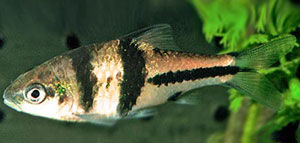The spanner barb, when fully grown, attains a length of approximately 4.5 – 6 inch, and it is mainly this big size that prevents it being included in the community category. They’re, nevertheless, fairly peaceful fish, but need big aquarium to home them.
The markings consist of two vertical bars, one just behind the gill cover and forward of the dorsal fin, the other below the forward end of the dorsal into which the colouring extends. A lateral line extends from the fork of the caudal fin to just below the rear of the dorsal. There are also four spots, two on the tail root, one on the back, just behind the dorsal, and one on the lower body near the forward edge of the anal fin. These dark markings are on a body colour of pale gold and also the fins are pinkish.
It is simply because of the position of the 3 main dark markings, which is representative of an adjusting spanner, that the spanner barb obtained its well-liked name.
These aren’t especially colourful fish and when they increase their size even the black marking becomes less distinct. These fish had been apparently initial introduced to the aquarist in 1932.
This species doesn’t like low temperatures; 70°F should be considered a minimum.
With regard to food, the spanner barb will eat the usual dried foods, but a diet of this nature won’t be satisfactory by itself; lots of live foods should be given to them. Favourite foods are daphnia and insect larvae.
Sex differences aren’t effortlessly discovered, but usually the male, when in breeding condition, has a much more intense body colour, and also the female a deeper body.
Breeding isn’t simple. Fish under 18 or 24 months should not be mated, but with fish over 24 months breeding could be attempted.
A partial change of water in the breeding tank might stimulate a spawning. The parents should be removed instantly after spawning, otherwise they’ll devour the eggs in record time. Numerous eggs are laid during a spawning, and hatch in about 3 days. The fry are able to eat food of micro-worm size in a very short time. Breeding temperature is 75° – 80° F.

